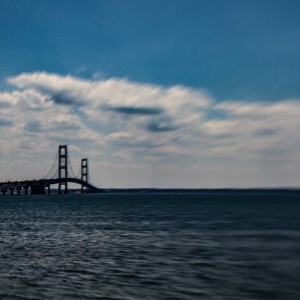Opposition leader assassinated in one of world’s dangerous clashes over industrial development.
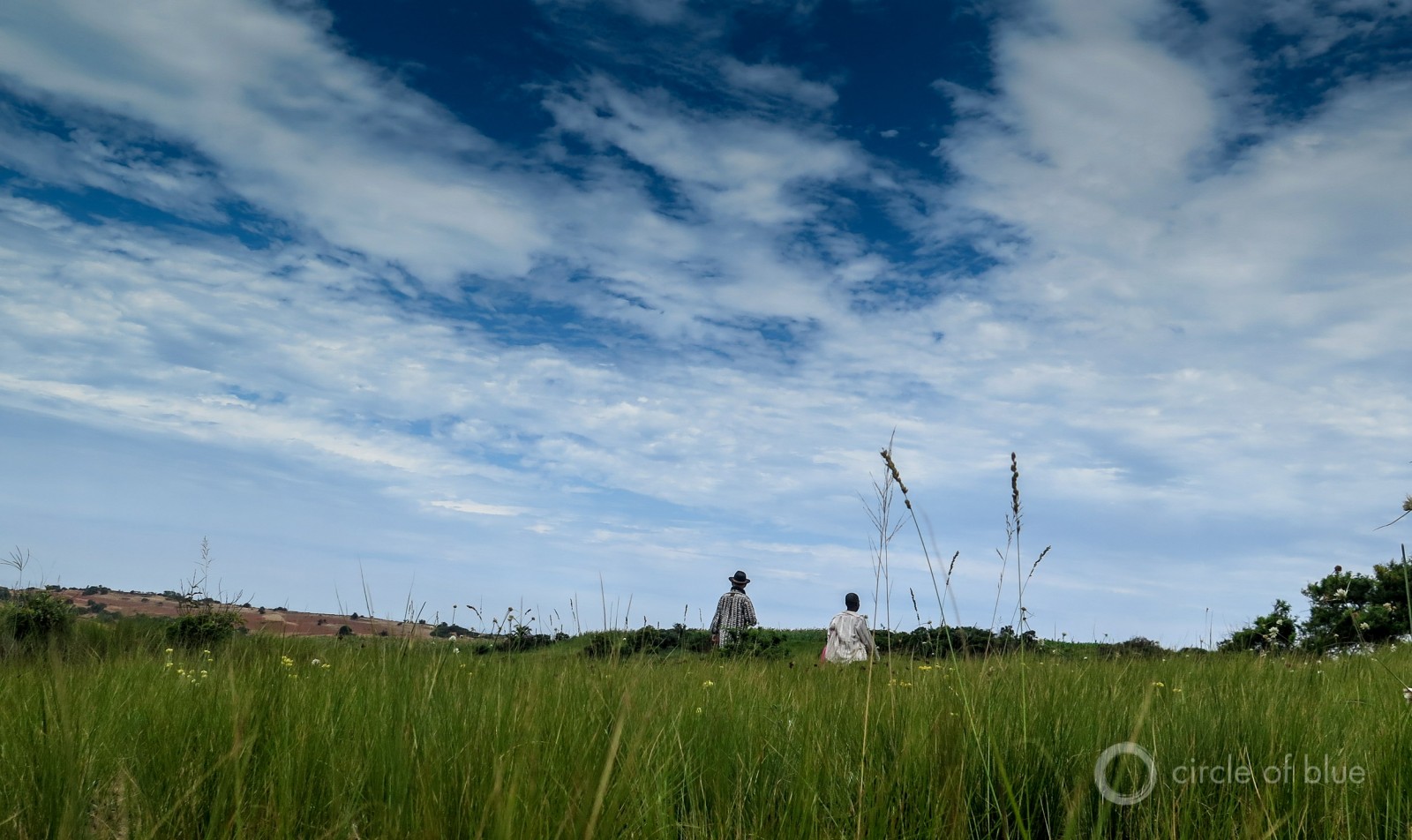
Ridge summits, cloaked in deep grass, rise and fall to an endless horizon on South Africa’s Wild Coast. There is scant intrusion by contemporary conveniences — paved roads, electricity, and running water. Photo © Keith Schneider / Circle of Blue
By Keith Schneider, Circle of Blue
PORT EDWARD, South Africa — On the evening of March 22, as lights blinked on in this seaside town by the Indian Ocean, a white sedan with blue lights fixed to the roof arrived in front of Sikhosiphi Radebe’s vehicle repair shop. Two men got out. They wore gloves, identified themselves as police officers, and firmly asked Radebe to leave the shop and accompany them to the waiting car.
Radebe instinctively recognized danger. He struggled with the men. Moments later Radebe was dead, shot eight times, according to an account by the South African Police. No suspects have been identified.
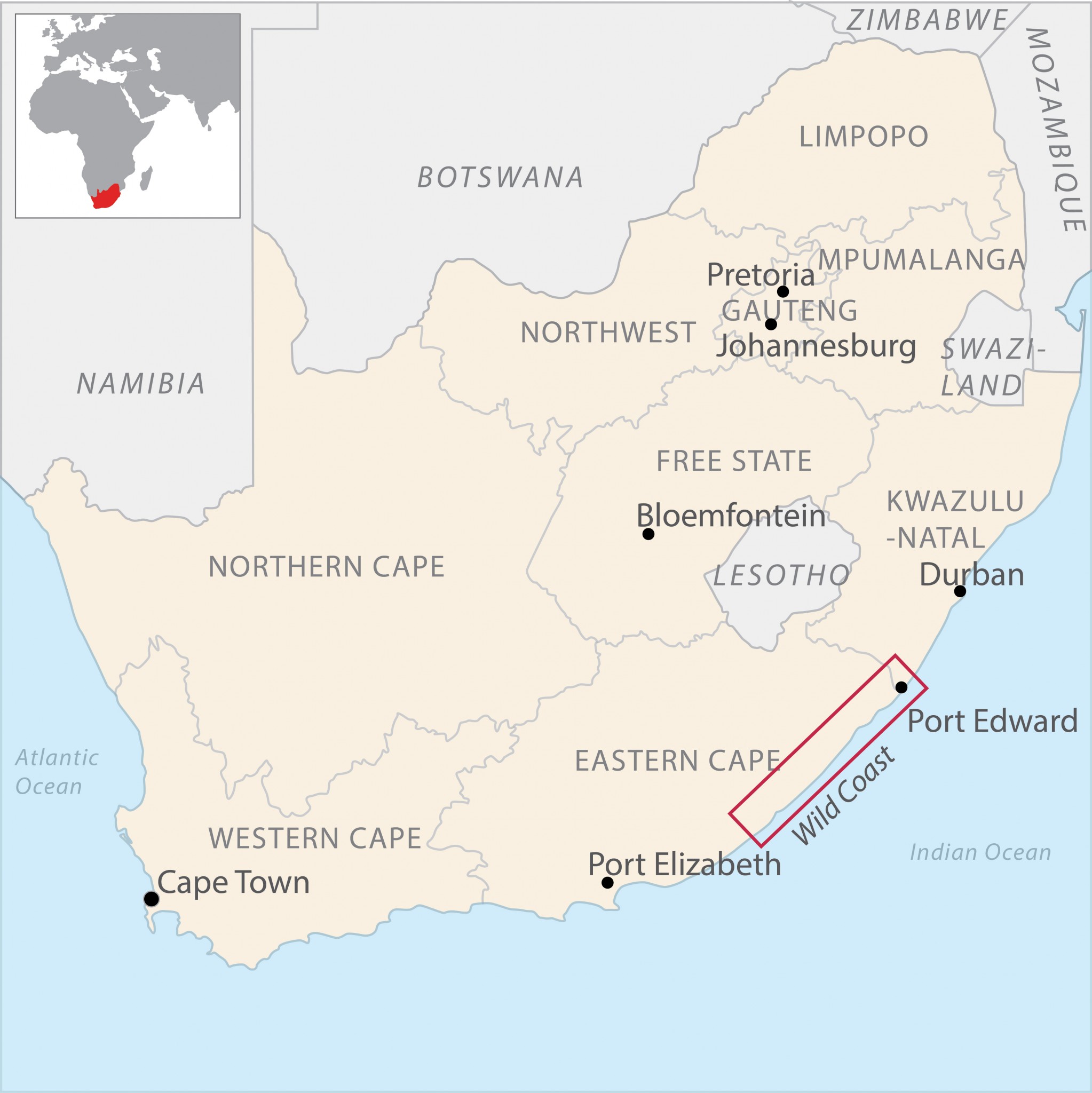
Map © Codi Kozacek / Circle of Blue
Radebe’s friends, and his son, who was with his father at the shop and witnessed the murder, are convinced they know the motive. The police don’t disagree. The 52-year-old taxi company owner and environmental activist, more commonly known as Bazooka, was the chairman of the Amadiba Crisis Committee.
The environmental justice group, formed in 2007, has led a tenacious, well-managed, and widely-recognized decade-long struggle for control of their traditional Pondo lands. The group is pushing uphill against an Australian developer intent on opening a big titanium mine on an unscathed 22-kilometer (13.6-mile) stretch of gloriously beautiful Wild Coast mineral sand beaches and dunes near the Xolobeni settlement. The South African government, whose view has generally been sympathetic to the mine, also wants to build a limited-access freeway nearby.
The conflict, in purer terms, pits against each other a western industrial company’s conventional view of economic development, the South African government’s effort to help, and an indigenous community’s bid to preserve its clean water, magnificent land, and agrarian way of life. More so than in many of the other global contests between indigenous people and industrial developers the stakes in the Crisis Committee’s work are soul-stirring.
Pondoland is one of the Earth’s stupendously beautiful places. Its sheer basalt cliffs drop straight into deep gorges and the blue waters of the Indian Ocean. Miles of mineral sand beaches attract waves of shore birds and schools of fish. Ridge summits, cloaked in deep grass, rise and fall to an endless horizon. Free flowing rivers pour down from the highlands. There is scant intrusion by contemporary conveniences — paved roads, electricity, and running water.
Radebe’s death caused a shudder in South Africa. Mosebenzi Zwane, the minister of the Department of Mineral Resources, issued a statement that “noted with concern the escalating tensions in Xolobeni,” and called “for calm, and for all stakeholders to use dialogue and due process in resolving their differences.”
Bazooka Radebe instinctively recognized danger. He struggled with the men. Moments later he was dead, shot eight times.
The South Africa Chamber of Mines, the leading mining industry trade group, and the two influential opposition parties, the Economic Freedom Fighters and the Democratic Alliance, also issued statements that expressed alarm about the murder and called for a thorough police investigation.
Mark Caruso, the chairman of Mineral Commodities Ltd., the Australian company seeking to develop the mineral sands, did not respond to an email inquiry from Circle of Blue. In an interview a day after Bazooka’s murder with Fin24.com, a respected South Africa news site, Caruso said he was “uninformed of any of the facts surrounding this incident, save other than to say that we do not condone violence in any form. It is tragic that a man has lost his life regardless of the circumstances, which in all fairness are yet to be established.”
To some extent those circumstances are all too familiar to leaders of indigenous groups fighting industrial interests supported by governments. A study by Global Witness, the London-based human rights group, counted well over 100 environmental activists around the world who were murdered in 2014. More than 140 were killed in 2012. Most of the local leaders died in Latin America and Asia. Earlier this month, prominent indigenous leader Berta Cáceres, who won the 2015 Goldman Environmental Prize for opposing a big new dam, was assassinated in her home in Honduras. Days later Nelson García, a 39-year-old colleague in the struggle, also was murdered.
South Africa has been different. This nation of 55 million residents witnessed hundreds of fierce local and regional clashes over rivers, mines, dams, and land rights. South Africa was not known as a place where environmentalists were killed as a result of their work. The Amadiba Crisis Committee, like other high profile campaigns, attracted considerable attention in South Africa’s media. The committee recruited prominent lawyers and policy experts in Johannesburg and Cape Town to be advocates in government and court proceedings. Two years ago filmmaker Riley Grunenwald released “The Shore Break,” a feature length documentary about the conflict in Pondoland.
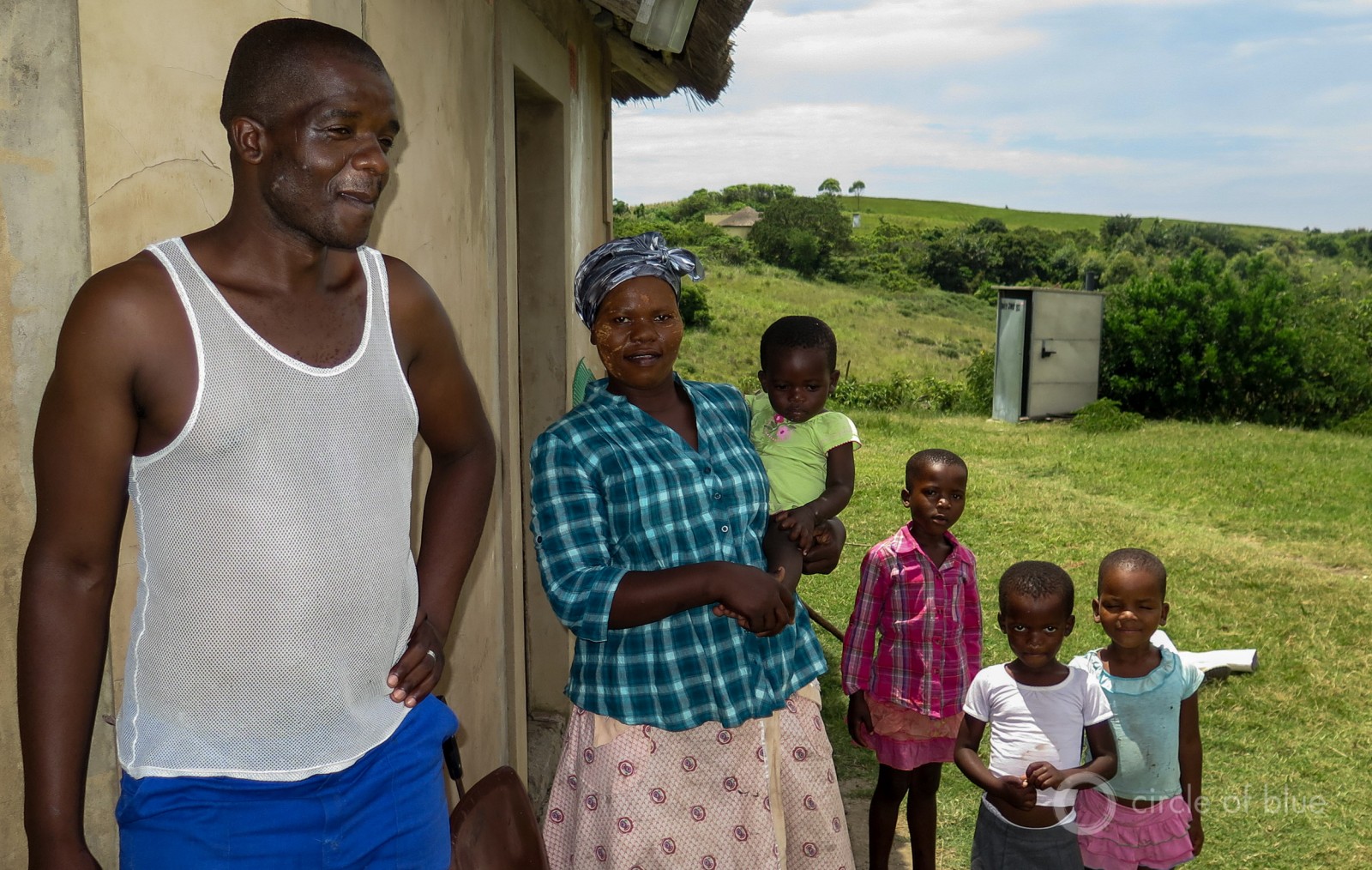
“This is our land,” said Zwelidumile Yalo, a farmer, here with his wife, three daughters, and a nephew, close to the proposed boundary of the new mine he loathes. “It will not be taken away from us.” Photo © Keith Schneider / Circle of Blue
Bazoooka’s murder is the first killing of a South Africa environmental leader, according to Global Witness. His death, and the instances of intimidation and assaults that preceded it over the last 10 months, turned the battle for Pondoland into one of the most frantic, unpredictable, and dangerous environmental campaigns in the world. Last week 82 environmental and human rights organizations from South Africa, and other nations in Africa and Europe, issued a joint statement that condemned Bazooka’s murder and called on the national Department of Mineral Resources to suspend its work to review a new titanium mining license application from Mineral Commodities “until there has been a full and independent investigation of Radebe’s murder.”
“The environment is becoming a key battleground for human rights,” said Billy Kyte, the senior campaigner for Global Witness. “Governments, like South Africa, are failing to protect these environmental defenders – often ordinary people – who face overwhelming odds.”
Land, Water, Community Integrity At Issue
To a surprising extent, the escalating war for the Wild Coast fits its time. Just as with oil, the planet’s easily recoverable minerals have been exhausted. Developers are prospecting in more inaccessible regions. At the same time, the world’s population has swelled to 7.4 billion.
There are more people in the world’s last mineral-rich rural and wild places. They tend to be well-informed and capable of waging effective opposition campaigns. In effect, the rules of the development game are much different than in earlier eras, when industrial companies descended on remote and unwary regions to mine and log and drill with scant resistance.
Pondoland is one of the Earth’s stupendously beautiful places. Its sheer basalt cliffs drop straight into deep gorges and the blue waters of the Indian Ocean.
Today, more often than not, indigenous groups fight hard and win. The source of their distaste for big water-guzzling, air-polluting, community-disturbing industrial projects is founded on a keen understanding of the myriad risks and thin civic benefits. In Mongolia, South Gobi desert herders campaigned so effectively to protect their groundwater that Rio Tinto was compelled to redesign and build a $US 7 billion state-of-the-art copper and gold mine that recycles most of its process water. In Peru, Campesinos in the Andes mountains north of Lima shut down Newmont Mining’s $US 5 billion Conga gold mine because of the water contamination they feared it would cause. In Assam, India, villagers blockaded access roads and halted construction indefinitely on the $US 2 billion Lower Subansiri dam.
In all three instances, and many others around the world, indigenous communities also rejected the dislocation, crime, loss of fisheries and wildlife habitat, and other collateral damage they knew would come with the big projects.
Similarly, the Amadiba Crisis Committee’s opposition is grounded in clear evidence, gathered from the Internet and personal experience, that makes a convincing case that the promises of employment and services made by Mineral Commodities and the government, and the assertions of safety for water, air, and land, are weak at best. Many of the Crisis Committee’s members have experience working in the gold and hard rock mineral mines that surround Johannesburg. They are familiar with the extensive water pollution, land degradation, and insecure job prospects in mining.
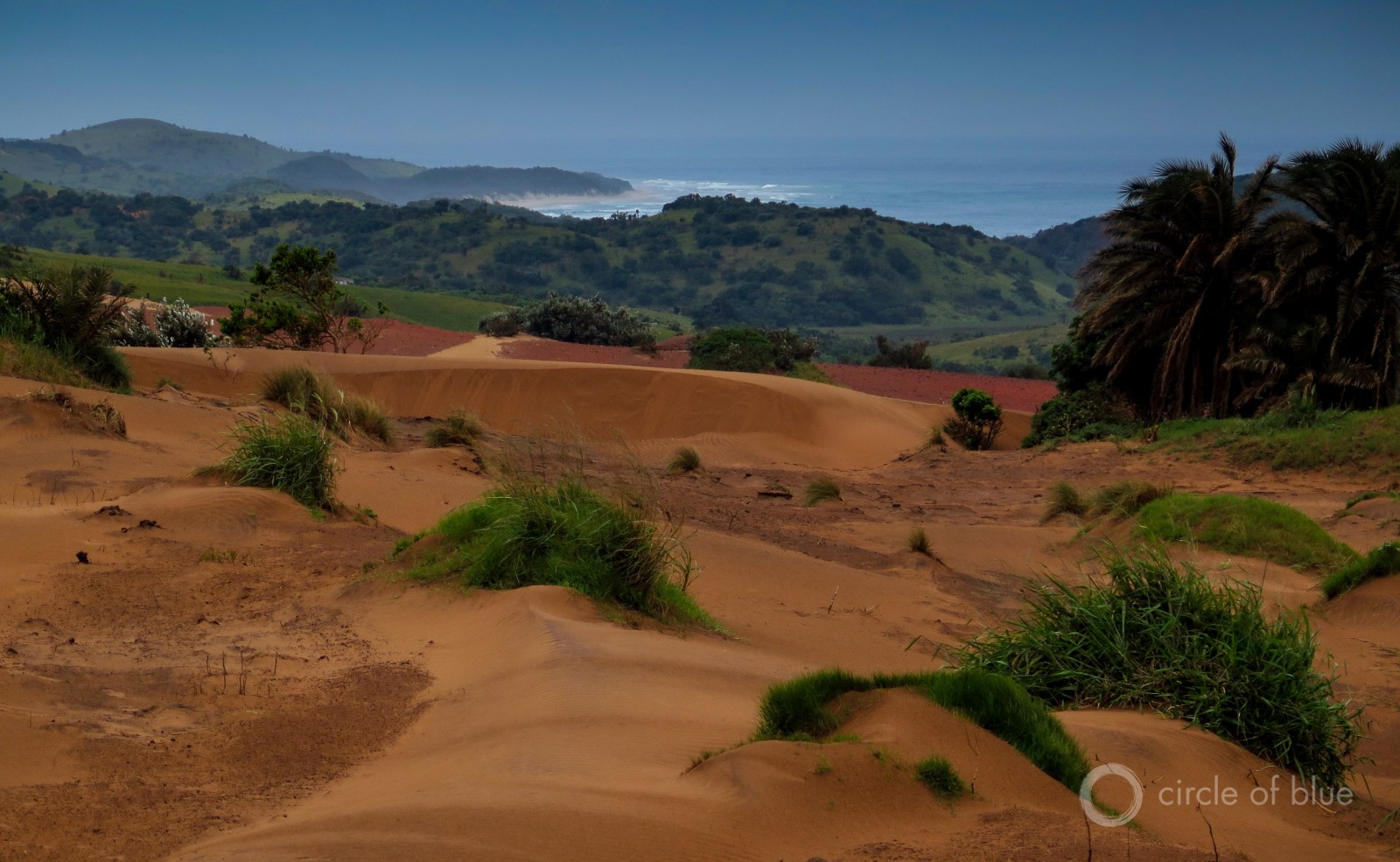
Mineral Commodities Ltd., an Australian developer, proposes to take control of 2,867 hectares of Wild Coast beach and dunes (nearly 7,100 acres) to produce 425,000 metric tons of processed titanium sands annually. Photo © Keith Schneider / Circle of Blue
Crisis Committee leaders insist they are not rejecting modernization. They just want to be much more circumspect about which aspects of it they will invite into their region.
“The South African Constitution gives people the right to clean water. It provides us the right to protect our land. We have national plans to provide all South Africans access to good roads and electricity,” said Nonhle Mbuthuma, the deputy chairman of the Amadiba Crisis Committee. “We shouldn’t need a mining company to provide those basic services here.”
Need For Mine and Highway?
One more factor confounds Mbuthuma and her colleagues – the diminishing need for the titanium mine, or a national freeway through her region.
Mineral Commodities proposes to take control of 2,867 hectares of beach and dunes (nearly 7,100 acres) to produce 425,000 metric tons of processed titanium sands annually. It will be trucked to export terminals in either Port Richards, Durban, or East London, all hundreds of kilometers distant. The mine needs 15 megawatts of electrical generating capacity to operate, may employ fewer than 300 people, and will use 15 million cubic meters of water annually (4 billion gallons). The company has not identified the source of all that water.
The Wild Coast mine’s two primary titanium minerals are ilmenite, used as a pigment for producing white paint, and zircon, used in ceramics. Mineral Commodities operates a similar titanium beach mine along the Atlantic coast north of Cape Town. The global market for both minerals is soft. Zircon prices peaked in 2011 at $US 2,600 per metric ton. It is now selling for under $US 1,000 per metric ton.
Near the turn of the 21st century South Africa launched a program to establish a national titanium smelting and processing industry. The effort has largely been abandoned due to international competition and weak market conditions.
The battle for Pondoland is one of the most frantic, unpredictable, and dangerous environmental campaigns in the world.
Still, Mineral Commodities persists in its effort to obtain all the licenses needed to start mining. The same doggedness describes the government’s work to build a new highway across the Wild Coast. Much of the proposed route for the 560-kilometer (350-mile) freeway follows existing two-lane roads between Port Elizabeth and Durban.
Some 96 kilometers (60 miles), though, is to be built on what engineers call “greenfield,” and what Crisis Committee members call their meadows, farms, unfenced grazing land, and villages. The greenfield route lies just a kilometer or two from the proposed titanium mine. The road, suitable for heavy mineral bulk-haul trucks, crosses five big river gorges that require expensive bridges. The current estimated cost of the section is close to $US 1 billion.
Both the mine and the highway are justified by government agencies as crucial to economic development. But before 2002, when Mineral Commodities first proposed the titanium mine, the villagers of the Wild Coast were steadily making progress on an economic development plan based on the Wild Coast’s undammed rivers, magnificent beaches, and scenic landscape. A popular and successful ecotourism industry began to thrive. Lodges opened along the coast. Fishing guide services opened.
The Eastern Cape government marketed the surpassing beauty of the Wild Coast. The province also opposed mining and supported the sustainable economic enterprises developing in Pondoland.
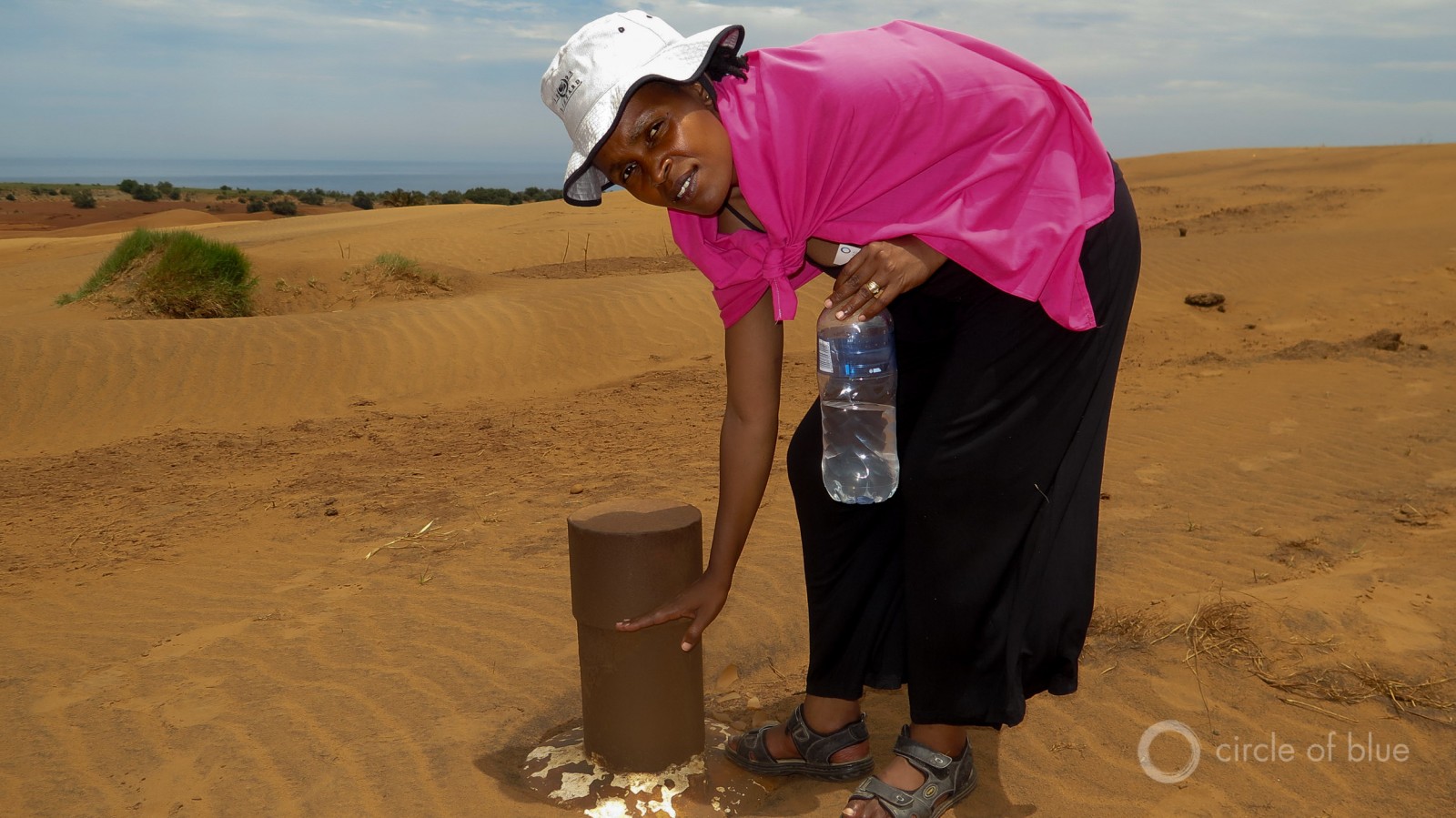
Nonhle Mbuthuma, a leader of the Amadiba Crisis Committee and close friend of Bazooka Radebe, has helped build a tenacious, well-managed, and widely recognized decade-long struggle for control of their traditional Pondo lands on the Wild Coast. Photo © Keith Schneider / Circle of Blue
“Surrounding communities are unanimous in their opposition to the mine,” said the authors of a 2014 report by the Eastern Cape Department of Economic Development, Environmental Affairs and Tourism. “It would require moving communities away from the area, destroying their livelihoods in the process, and potentially causing irreparable damage to the surrounding environment and curtailing any hopes of developing a viable ecotourism industry in the region.”
Nonhle Mbuthuma and a colleague, Mzamo Dlamini, worked as guides for Amadiba Adventures, which established a string of huts, a herd of horses, and trained guides to take tourists on multi-day horseback treks across the beaches and gorges of the region. As many as 60 people were employed directly by the company as guides and staff members, and 100 more indirectly as craftsman and suppliers serving tourists.
Amadiba Adventures crumbled quickly in 2005 as Mineral Commodities gained traction with its licensing applications, and the government pressed its case for the new road harder. The company’s owners sided with the mining company and neglected the business, said Mbuthuma. Dlamini said the company’s headquarters burned to the ground.
By 2008, when the Department of Mineral Resources quietly granted Mineral Commodities a license to commence developing its titanium mine, the development proposal had begun to stir powerful protests. A deep social schism opened in Pondoland. Families divided over preservation or development. Old friends stopped talking to each other.
The South African government, and a sizable group of local residents, assert that the mine and new highway are essential in a strenuous landscape that encircles some of the country’s deepest pockets of illiteracy and shackles thousands in poverty. Supporters say conventional development steps are the most suitable path to jobs, new schools, paved roads, and easier access to the region’s large urban centers. Members of both sides vow to fight to the death.
“This project will bring plenty of opportunities in this place and help us fight poverty,” said Nteheleto Madikizele, a mine supporter who lives near Xolobeni, the closest village. His comments came in an interview in May with Fin24.com. “We, the people of Xolobeni, are determined to bring mining to this area. We are prepared to die to realize that dream.”
To a surprising extent, the escalating war for the Wild Coast fits its time.
“Government says that our area is one of the poorest in the country,” replied Mbuthuma. “When shall this stupidity stop? You answer us: How can we be poor when we have land? We grow maize, sweet potatoes, taro, yams, potatoes, onions, spinach, carrots, lemons, guava and we sell some of it to the market. We fish and we eat egg and chicken. This agriculture is what should be developed here. It is not falling apart like in many other places in Eastern Cape.
We have cattle for weddings and traditional rituals. We have goats for ceremonies. We are not a part of the ‘one out of four South Africans who go hungry to bed.’ We have a life.”
“This is our land,” added Zwelidumile Yalo, a farmer who lives with his wife and three small children close to the proposed boundary of the new mine he loathes. Yalo’s corn fields and vegetable gardens lay in the fertile bottoms of nearby ravines. His livestock graze on tall grass. His ancestors are buried in the shade of acacia trees.
“It will not be taken away from us,” Yalo said through an interpreter to Circle of Blue. “We will not let that happen.”
A Murder Stirs More Conflict
The night he was killed Bazooka called Nonhle Mbuthuma. There is a hit list, he told her. His name was first on the list. Her name was second. The third person listed was Mzamo Dlamini.
Mbuthuma was not surprised. For well over a year the 38-year-old activist, her husband, and two-year-old son lived in a home kilometers away from the Wild Coast, where she believed they were safer. A determined woman, Mbuthuma is cautious in her public appearances. She lives with the knowledge that her life is in danger.
On the day in January when she and Dlamini accompanied a Circle of Blue reporter to the site of the planned mine, both were wary. Periodically along the torturous dirt road that led to the mine site local residents who also were Crisis Committee members hailed her vehicle to check who was inside, and then to share intelligence. Unfamiliar vehicles are stopped and turned around. Over the last year homes of opposition leaders have been attacked at night by armed men. There have been repeated assaults. Death threats are common, says Mbuthuma.
Mine opponents have responded by developing an effective communications grapevine and, when they deem it necessary, blockading roads to prevent mine executives and government officials from gaining access to the mine site. The escalating tension is consuming a Pondo culture that prizes persistence and is accustomed to battle. In the 1950s and 1960s, in one of South Africa’s most revered instances of resistance, Pondo men and women fought their own leaders and government security forces to block an effort to install Apartheid-era restrictions in the region. Many were killed.
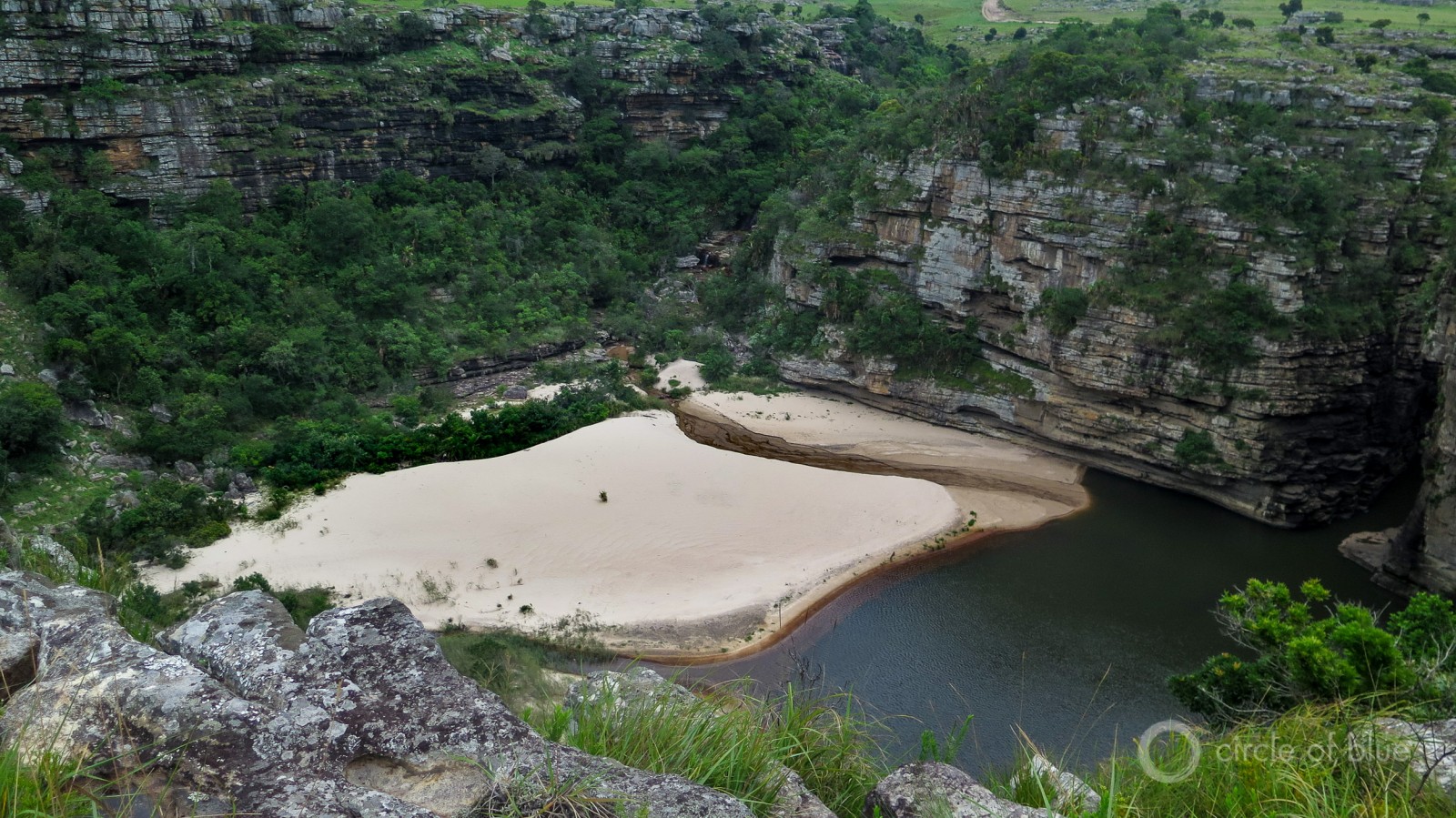
Pondoland is one of the Earth’s stupendously beautiful places. Its sheer basalt cliffs drop straight into deep gorges and the blue waters of the Indian Ocean. Miles of mineral sand beaches attract waves of shore birds and schools of fish. Photo © Keith Schneider / Circle of Blue
“We feel like history is repeating itself,” said Mbuthuma. “The Apartheid government tried to impose its racist policies on us. We fought them. Now our black government is doing the same thing. I just can’t believe what they are doing. In some ways they’re worse than the previous government.”
Both sides have claimed short-lived victories. In 2008, Mineral Commodities gained a license to begin mining. In 2011, following an appeal, the Amadiba Crisis Committee appeared to have won when the Department of Mineral Resources revoked the mining license. The committee also is filing appeals to block the highway agency’s administrative steps to build the new road.
The 2011 mining license revocation was based on what the department said were weaknesses in the application. The ruling, though, left open the opportunity for Mineral Commodities to restart the licensing process by March 6, 2015. Two days before the deadline, on March 4, 2015, the company submitted a new license application to mine the Indian Ocean beach.
The new application ignited a furor. A public meeting to discuss the latest developments in the campaign to stop Mineral Commodities broke up in a melee between opponents of the mine and a group of its supporters, who were armed. Shots were fired and one opposition campaigner sustained injuries to his head.
“We’re going to continue forward, no matter if we lose some soldiers on the way,” — Nonhle Mbuthuma, deputy director, Amadiba Crisis Committee
In late December supporters of the mine conducted a nighttime raid on Wild Coast villages and the homes of Crisis Committee supporters. Several mine opponents sustained serious injuries. Four of the attackers were arrested. One was affiliated with Mineral Commodities’ two-year-old beach mine north of Cape Town. Their trial is scheduled to start in April.
In February, executives of the black empowerment company affiliated with Mineral Commodities announced that it would begin exploratory drilling operations at the mine site. The Amadiba Crisis Committee organized a human blockade. People prepared to lie down in the road leading to the mine site. The company decided not to pursue its plan.
Two days later, on February 24, Bazooka was called by a mine supporter and threatened, according to Mbuthuma. The caller told Bazooka: “You think you are the Goliath of the Amadiba people, but even Goliath died.”
In an article published this week in GroundUp, a Cape Town-based news organization, Nonhle Mbuthuma revealed the depth of her courage. “Our enemy wants us to lose focus,” she said. “If we go to war then that will be the end of our struggle.”
Bazooka’s death, she said, is a formative new call to action. “I told myself to stop being stupid, that responding with violence wouldn’t protect the land. Before Bazooka died we took an oath that we would fight until the end. We’re going to continue forward, no matter if we lose some soldiers on the way.”
Bazooka’s funeral occurs on Saturday. Organizers anticipate it will attract an enormous number of mourners.
Read more of Circle of Blue’s Choke Point: South Africa reporting.
Circle of Blue’s senior editor and chief correspondent based in Traverse City, Michigan. He has reported on the contest for energy, food, and water in the era of climate change from six continents. Contact
Keith Schneider





